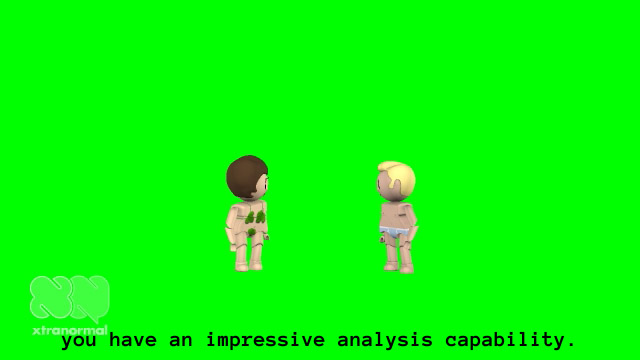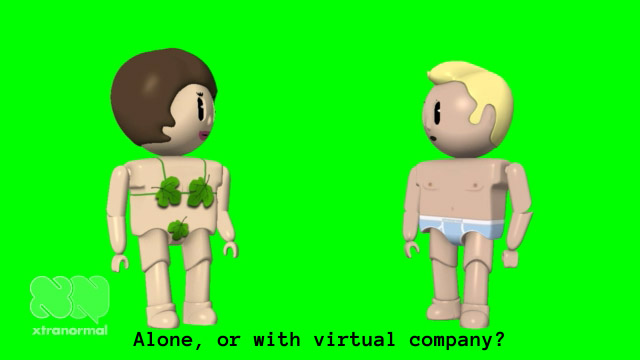from pastelegram.org, June 2011 – April 2014
Frances Stark: My Best Thing
My Best Thing, a feature-length film by LA-based artist Frances Stark, addresses the awkwardness of flirtation, meeting someone new, and how patterns of sexual attraction become intermeshed with the rest of one’s life. The film follows Stark's forays into online sex chat rooms, where she becomes involved with two younger Italian men over ten episodes. Their conversations play out via a tele-type scroll made from free text-to-speech software with their characters portrayed by two CGI stock dolls resembling Lego characters with dapper tufts of plastic hair and well-placed fig leaves.
The film starts in the middle and ends with the beginning. Opening scenes have Stark and her sexcam partner, Marcello, talking dirty. Their sexless bodies, flat faces and computer-generated voices temper the raunchiness of their otherwise masturbatory conversation. Wincingly humorous, the chats resonate powerfully; full of wide-eyed pauses, winks, blinks and shifts from side-to-side. The characters fully animate in segues between episodes, dancing and grinding to dancehall music. During the early parts of the film, Stark admits that she is in the middle of a "heavy dancehall phase.”

Marcello and Stark develop a tangible passion. While often hesitant, this passion breaks the digital and geographic divide as their steamy sex banter segues into mutual interests in history, politics, film, pop culture and their own work. Choppy digital and linguistic flaws are striking in the film, with extended blank stares representing time passed and slip-ups in language remaining; the voice software has her in computer-generated English and him in heavily accented Italo-English with subtitles.
It turns out that Marcello is a filmmaker, and their developing friendship leads her to ask him if he would be interested in collaborating in her upcoming work to be shown at the Venice Biennial. Marcello agrees and hopes to visit, joking that he hopes to win the Cinema Venice Biennial one day. Their collaboration plans are cut short, as Marcello’s politics get him in trouble with the police and he disappears from the chat rooms after being badly beaten at a protest in Rome.

The film continues with a second Italian man who she originally believes to be Marcello, but turns out as someone very different, a lazy young man whose parents are filmmakers. When Stark learns that his father won the Venice Biennial, the coincidence leads her to tell him about the project that she continued without Marcello. The film continues and ends with a self-reflective discussion of the film’s value and worthiness as an artwork.
Concepts of real-time versus geographic-time versus filmic-time come into play. The two must steal time away from their day, adjust to time differences of one’s morning being the other’s late night. Pieced together as clips from months of conversation, the narrative’s form also expresses an odd sense of time.

Yet the digital divide takes a backseat to the more physical and emotional divides. Soap opera styling, humor, sex and philosophical meandering lead the viewer through the film from a seedling of an idea to its production and analysis. As an overly self-aware and self-professed attention whore, Stark, as heroine, displays vulnerability. Trying to regain the intimacy of her connection with Marcello, she reaches out awkwardly to the second young man, whose name we never learn. Stark imbues My Best Thing with a raw and diaristic vulnerability as well as a prevailing meta-doubt through Stark’s openness about her anxieties about juggling being a woman, girlfriend, teacher, artist and mother of an eight-year old child.
Despite her vulnerability, with all her slip-ups on view, Stark is not a character out of control. She brings Marcello into her work; then he is replaced by a different and more child-like character that she draws into the narrative with a near-motherly control. Borrowing from what exists around her—be it images, language, pop culture—Stark pulls her environment into her own repertoire and declares her artistic authorship. All the while, she knowingly teeters on female and artistic stereotypes of being desperate, haughty or oversensitive. She uses her awareness of the creative process and her own faults as advantages, and her complicated process and shifting identity make her a difficult artist to pinpoint. That avoidance of easy classification is primary to the meaning and importance of her work.